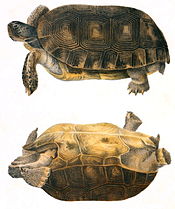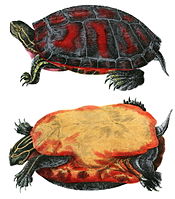- Cumberland slider
-
Cumberland slider 
Scientific classification Kingdom: Animalia Phylum: Chordata Class: Reptilia Subclass: Anapsida Order: Testudines Family: Emydidae Genus: Trachemys Species: T. scripta Subspecies: T. s. troostii Trinomial name Trachemys scripta troostii
(Holbrook, 1836)The Cumberland slider (Trachemys scripta troostii) or Cumberland turtle, is a semiaquatic turtle (terrapin) of the family Emydidae.
Contents
Taxonomy
This subspecies of T. scripta was formerly placed in the genus Pseudemys. It is also known as the Cumberland turtle. It also occurs in a different geographic location from the yellow-bellied slider (Trachemys s. scripta). Intergradation does not occur between these two forms. The generic status of this species has long been a controversial subject.
Description
The carapace is olive brown with yellow markings. It has two rounded projections on the posterior edge of the shell, and is slightly keeled. The adult carapace is wrinkled and oval-shaped. The plastron is hingeless and slightly smaller than the carapace. Each of the bottom sides of the marginals has a spot. The skin is brown with an olive to greenish tint with yellow striping. There is a distinct bar behind the eyes that can vary from yellow to red and be either thin or wide. The plastron of the turtle has dark spots, as well as the ridge of the carapace. Also, the plastron has bars or stripes of yellow. The turtle's legs in front have larger yellow stripes than most slider species, and the eyes have a yellow and orange stripe directly behind each eye. The stripe is never entirely one color, it starts out yellow and then fades into a dark orange-to-red color closer to the back of the neck.
Behavior
This turtle is a communal basker. It basks on protrusions out of the water and may bask in stacks or with other species. They are active from April to October. 'Slider' comes from their habit of sliding into the water when alarmed when basking, because they go to deep waters for safety where most predators cannot pursue them.
Habitat
It is found throughout the Mississippi and Tennessee River drainages, and the southeastern U.S. This species prefers quiet waters with muddy bottoms. Areas like ponds, lakes, and streams with a profusion of aquatic vegetation, organic substrate, and overhanging basking spots are especially favored. Most people agree the native lands of the Cumberland slider are in the Cumberland River Valley, ranging in Kentucky and Tennessee. But with the exotic animal trade, the Cumberland slider has become a common sight even into Alabama and Georgia. [1]
Reproduction
This turtle breeding takes place in spring, fall, and winter months. The male and female go through a mating ritual where the male 'claws' at the female's face and his forelegs stiffen. The female then allows the male to mount. The females may go extremely far from the water to nest and are often hit by cars while crossing roads. Females construct a nest, usually at night, in various soil types. Clutch size is 6-15 eggs with 71 percent of the females producing two clutches per year.
Diet
This turtle is omnivorous as an adult, but primarily carnivorous as a juvenile. The adults eat algae, fish, tadpoles, crayfish, seeds, plants, aquatic vegetation, insects, worms, and mollusks. This species, like all aquatic turtles, can only swallow food when in the water.
References
Order Testudines (turtles) Suborder SuperfamilySubfamily
Cryptodira Caretta · Chelonia · Eretmochelys · Lepidochelys · NatatorDermochelysDermatemydidaeDermatemysStaurotypinaeBatagur · Cuora · Cyclemys · Geoclemys · Geoemyda · Hardella · Heosemys · Leucocephalon · Malayemys · Mauremys · Melanochelys · Morenia · Notochelys · Orlitia · Pangshura · Rhinoclemmys · Sacalia · Siebenrockiella · VijayachelysAldabrachelys · Astrochelys · Chelonoidis · Chersina · Cylindraspis · Geochelone · Gopherus · Homopus · Indotestudo · Kinixys · Malacochersus · Manouria · Psammobates · Pyxis · Stigmochelys · TestudoTrionychiaCarettochelyidaeCarettochelysTrionychinaePleurodira ChelidinaeChelodininaeHydromedusinaePhylogenetic arrangement based on turtles of the world 2010 update: annotated checklist. Extinct turtles not included.
See also List of Testudines families
 Portal ·
Portal ·  WikiProjectCategories:
WikiProjectCategories:
Wikimedia Foundation. 2010.

